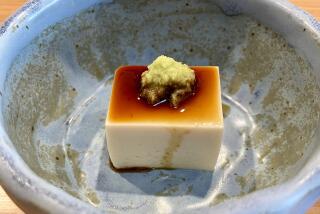Japan’s Traditional New Year’s Feast Takes on Western Flavor : Culture: The 15 items of the <i> osechi </i> meal are rich in meaning. The meat balls aren’t.
- Share via
TOKYO — Atsuko Iizuka spent the last two days of December doing what generations of Japanese women before her have done to ring in the New Year: simmering, boiling, baking and broiling 15 separate items for an elaborate feast called osechi .
A highlight of the three-day holiday season that begins today, the New Year’s feast is a dazzling array of colors and tastes with meaning imbued in each of the main elements. ( Osechi can also be dazzlingly expensive. Iizuka spent $180 for the ingredients alone, but the spread sells for as much as $900 if custom-ordered from the finest Japanese restaurants.)
Fish eggs symbolize the hope for many offspring. The yellow of the sweet potato and chestnuts is meant to ward off bad spirits. The seasoned dried fish, written with Chinese ideograms that mean 50,000 grains of rice, is a wish for bountiful harvests.
The rolled egg symbolizes the wisdom of the ages handed down in Japanese scrolls. The black beans signify the desire for the health to work hard enough to soil the face with sweat and dirt, explained Iizuka’s husband, Masao.
The red and white of the fish cakes are congratulatory, and the rounded rice cakes symbolize the dawning sun of the new year. Traditionally, five flavors, colors and cooking styles are used; the food is seasoned to keep for a week to give women their only vacation from the kitchen all year.
“Most Japanese don’t actually think about these meanings,” Iizuka said. “And young people nowadays don’t even like to eat osechi much.”
Indeed, international influences are permeating even the deepest traditions here and changing the tastes of modern Japanese. The Tokyu Department Store, for instance, offered sets of Chinese and Western osechi alongside the traditional Japanese spreads. Never mind that roast beef, smoked salmon and meat balls utterly lack any cultural meaning. To scores of Tokyoites, the international offerings taste better--and were sold out by Friday.
“Older folks go for the Japanese sets, but the younger people buy the Chinese and Western,” Tokyu’s osechi vendor said.
New Year’s arrangements of pine, bamboo and plum--all good luck symbols--also showed Western influences: Snoopy and Woodstock sat perched in some of them and graced the children’s kites that traditionally portray scenes of sumo wrestlers or geisha.
If modern tastes are eroding tradition, so is the recession. Tokyu’s sales of the osechi sets, which average about $250, fell to about 700 this year, compared to 1,200 during the era of the economic “bubble” four years ago, a spokesman said.
Daijin Yoshikawa, who has sold New Year’s wreathlike arrangements for the last 15 years, said his sales have been down for the past three years. During the boom days, he could sell some arrangements for $135; now he’s lucky to move the ones priced at $35.
To counteract the recession, the famous Ameyoko fish market in Tokyo’s Ueno district dropped prices by 30% and managed to pull in the same number of customers as last year--about 740,000 on Wednesday, with projections of 900,000 for Thursday.
But the most crowded place in Tokyo on New Year’s Day will be Meiji Shrine, where an estimated 3.5 million people are expected to visit over the three-day period, police predict. Nationally, 87.5 million people are expected to visit shrines--the highest number in history. Police say that clear weather and a heightened desire to appeal to the gods for relief from the recession and rice-crop failure are reasons for the surge.
Besides feasting and praying, many Japanese will spend time reading postcards, called nengajo , from friends, relatives and business associates delivered on New Year’s Day. This year, the cards will be embossed with a pooch: 1994, according to the cycle of zodiac symbols based on the Chinese lunar calendar, is the Year of the Dog.
The dog year, which comes around every 12 years, has not been particularly fortuitous for Japan. The dubious hits list includes the annexation of Korea in 1910, grabbing Manchukuo through a puppet emperor in 1934, the cutoff of trade ties with China in 1958 and the Lockheed bribery trials in 1982.
This year also projects gloom: The Japanese economy is still going to the dogs, and Prime Minister Morihiro Hosokawa will face a dogfight getting his reform bills passed.
More to Read
Eat your way across L.A.
Get our weekly Tasting Notes newsletter for reviews, news and more.
You may occasionally receive promotional content from the Los Angeles Times.











